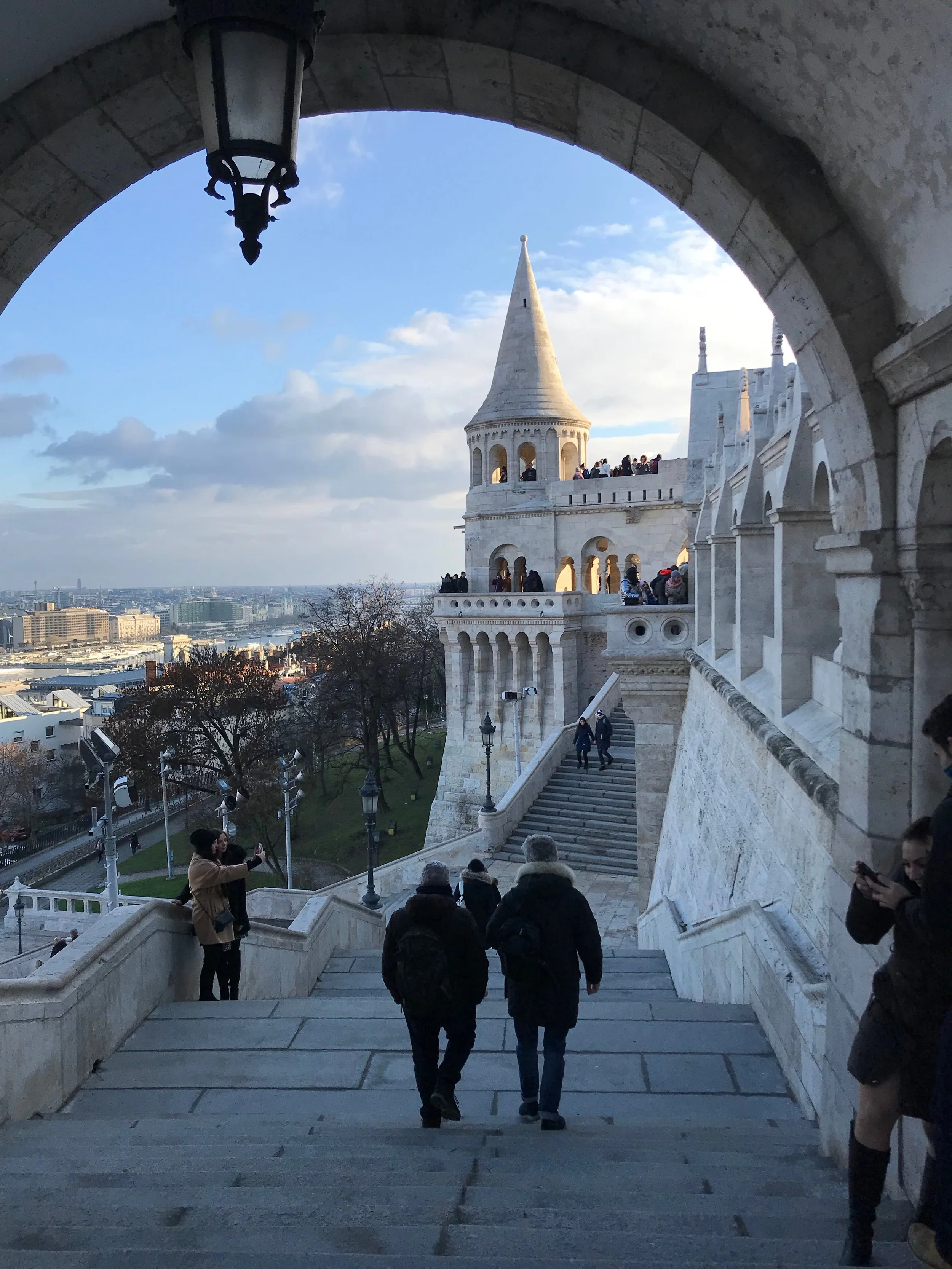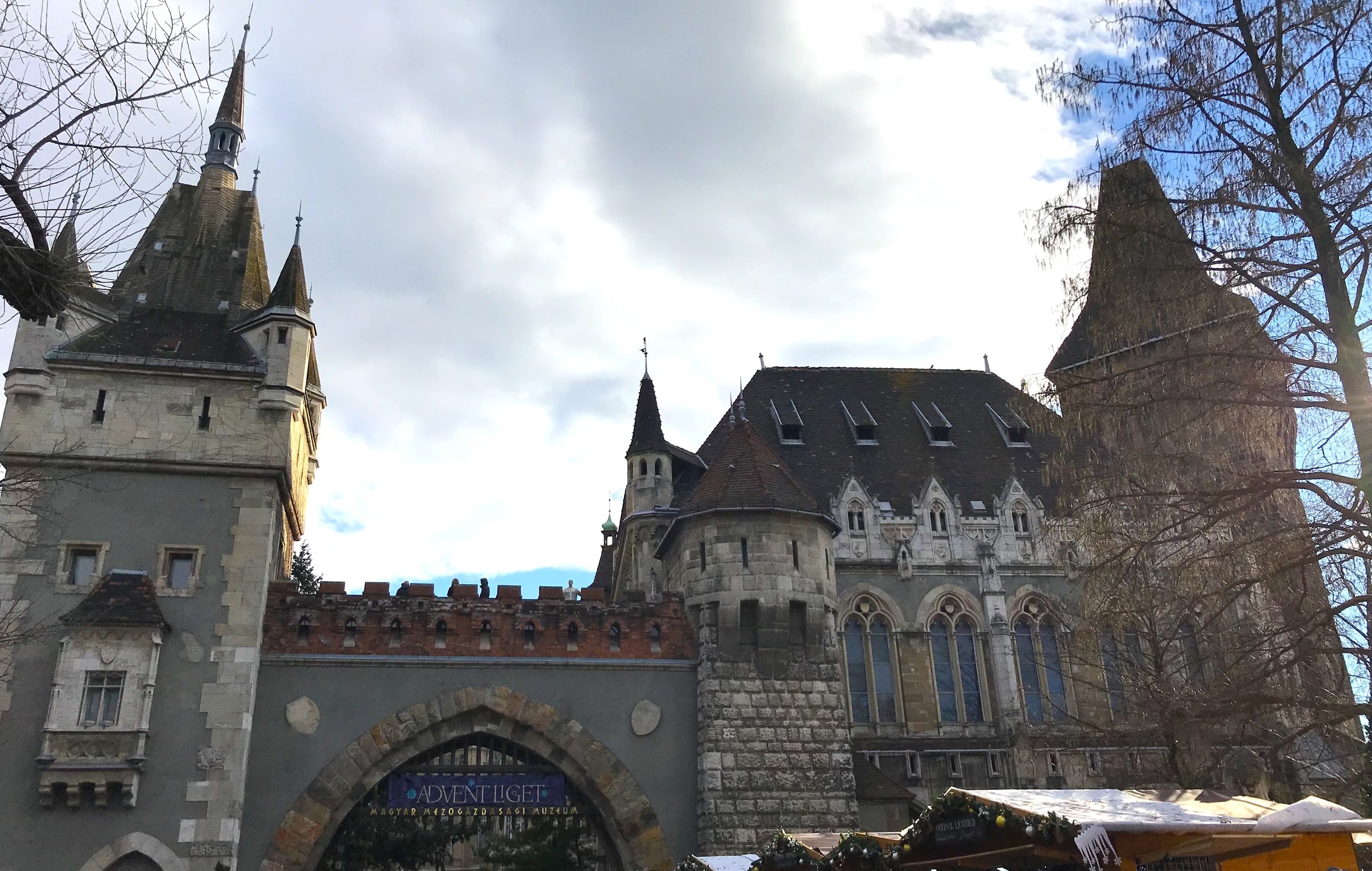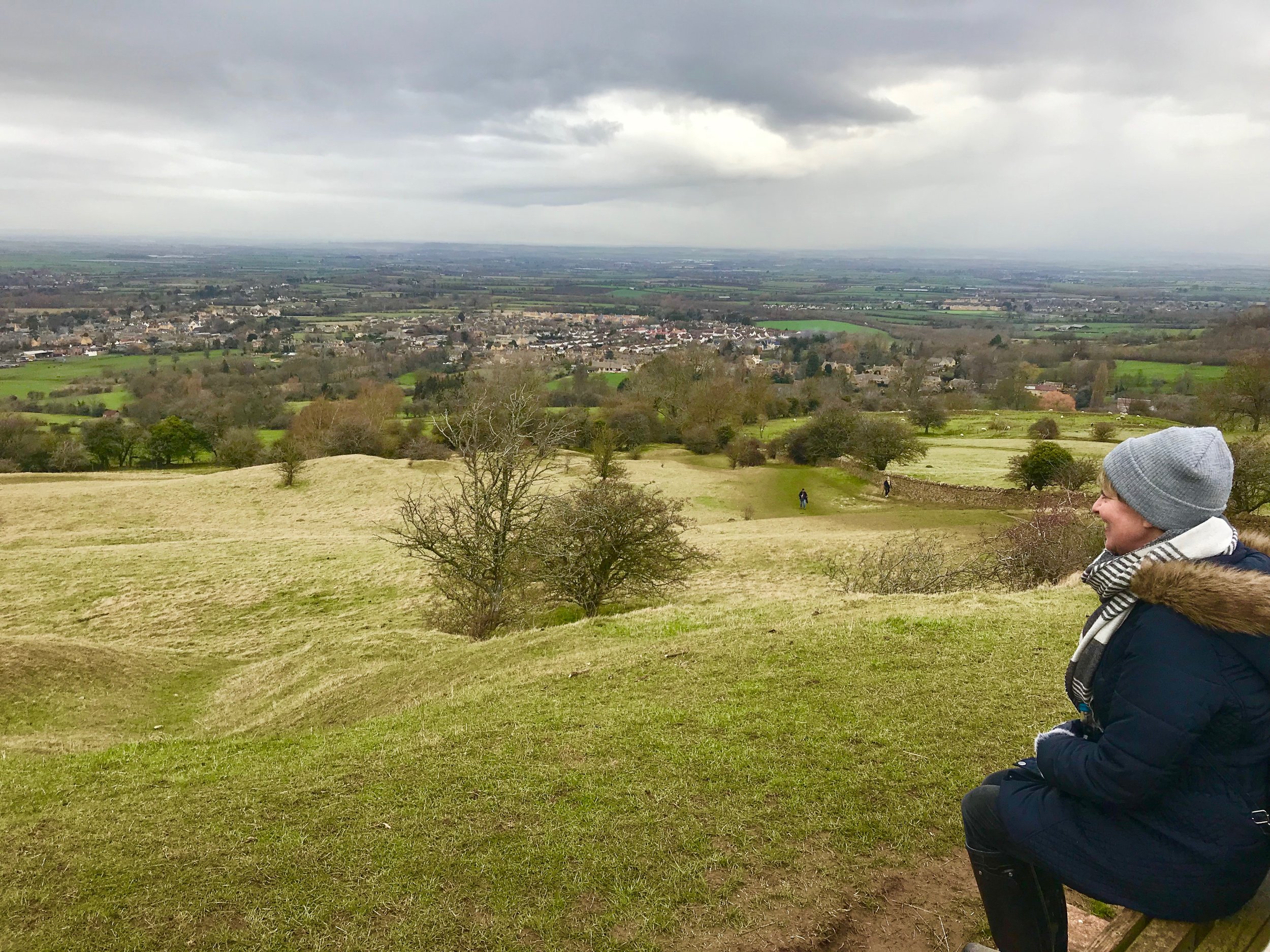Why Budapest is such a great destination for a city break
Budapest from Fisherman’s Bastion on Castle Hill
It has great vistas
Split into two halves - Buda and Pest - by the majestic Danube River, the tourist heart of Budapest is mostly pretty flat (the more residential Buda side of the city, behind the Castle is hillier). But the rise of Castle Hill and the adjacent Gellert Hill, topped by the Citadella, and the views afforded from the tops of some buildings and attractions on the Pest side, mean there are a variety of ways to see the sweep of this attractive city, with it’s skyline free of modern high-rise construction, only punctuated by the elegant domes and spires of its historic buildings.
The towers and walkways of Fisherman’s Bastion
Fisherman’s Bastion, on Castle Hill (pics above and below), was designed and constructed by the architect of Matthais Church specifically as a panoramic vantage point, and aside from being an architectural confection worth seeing for itself, it’s a great place to get a scenic view across the whole city.
A view of the city from the steps leading up to, or down from (depending which way you’re going!) Fisherman’s Bastion
Nearby 13th century Magdalena, or Buda, Tower, which only opened to the public again in 2017 after a lengthy renovation, is worth the 170 step climb for the views it gives you over the old Castle District. The tower is open every day from 10am to 6pm and costs HUF 1500
The view from the top of the Magdalena Tower
There are various ways to be transported up Castle Hill, including the historic, but frankly overpriced, Funicular (built in 1870), as well as paths and steps to make your way (for free) on foot. But leg power is the only way to get to the top of the neighbouring Gellert Hill, and the Citadella fortress (currently closed), and it’s a steep climb that’s partly path, partly steps. At the top you’re rewarded with a plinth-upwards view of the impressive Liberty Statue and a variety of vistas along the Danube and across the city (sadly rather hampered by extremely low cloud and rain the day we visited).
Over on the Pest side of the city, The Basilica of St Stephen is named after the first King of Hungary and was redesigned half way through its construction to make it exactly 96 metres tall in order to mark the Hungarian millennial celebrations of 1896.
Basilica of St Stephen
We climbed up to the balcony around the dome (a winding staircase which takes you past the inside of the dome) at dusk, the perfect time to enjoy seeing the panoramic views of the city come romantically alight (admittedly helped by the fact that all the Christmas decorations and lights were still in place).
The Basilica is open from 9am to 5pm Mon-Fri, 9am to 1pm on Saturday, and 1pm to 5pm on Sunday. Admission is free but donations are welcome, and it costs HUF 500 to climb the tower.
View across Pest towards Buda from the dome of the Basilica of St Stephen
The Budapest Eye from the dome of the Basilica of St Stephen
For a more recently man-made sky-high view of Budapest, jump on one of the gondolas on the Budapest Eye. You get three rotations of the giant ferris wheel (one of which is stop-start whilst they load the gondolas) so plenty of chance to take in the variety of vistas offered as you swing (figuratively, they really don’t swing much) up and above the rooftops and then down again.
Check opening hours and ticket prices here
It has great historic buildings
Whilst it’s true that many of the buildings in Budapest are more run down than you’d expect, the grandeur of its historic architecture more than makes up for the surprising shabbiness of many of the residential and office properties.
Of course, there are the famous landmarks including, on the Buda side, the magnificent Royal Palace, also known as Buda Castle. Today it houses the Budapest History Museum and the Hungarian National Gallery. I’m afraid I can’t report on either as we chose to spend the majority of the unexpectedly sunny time we had, outside buildings rather than inside them.
The Royal Palace
Alongside the Castle is the neo-Gothic Matthias Church, part of which still dates from the original 13th century building. But the majority of it was reconstructed in the 19th century under the direction of architect Frigyes Schulek (who was also responsible for Fisherman’s Bastion). The church is as playfully decorative inside as it is out. Click here for opening hours and admission details
Matthias Church. Outside…
….and inside
One of the many eye-catching decorative details
Another significant religious building not to be missed is on the Pest side. The Dohany utca, or Great Synagogue is the second largest in the world and can accommodate a congregation of 3,000 worshipers. Located at the gateway to the Jewish quarter of the city and built in a Moorish style, it has a memorial park named after the Budapest-based Swedish diplomat, Raoul Wallenberg, who saved many Jews in World War II and, unusually for a synagogue, a small cemetery containing mass graves of the Jews massacred by their fellow Hungarians in 1945.
Opening hours and admission here
In the memorial park at the rear of the synagogue, a poignant sculpture of a weeping willow has the family names of all the Jewish victims of the Second World War inscribed onto its leaves
Also on the Pest side and presiding majestically over the riverfront is the Orszaghaz or Parliament building, one of the largest in the world. Although only 12% of the space (and 691 rooms) is actually used for governing Hungary. The intricate exterior is a visually saturated mix of neo-classic, renaissance and baroque styles. You can take a tour inside but tickets are limited so it’s best to book on-line (here). We didn’t, so sadly didn’t get to see the Sacred Crown, which was a gift from the Pope to St Stephen in AD 1000, or the numbered cigar holders outside the Upper House where members would leave their Havanas during debates.
The huge and ornate Parliament
A building renovated to its original turn-of-the-century glory is also one of the few tourist sites which is used by locals. Inside the Great Market Hall are rows of market stalls selling fresh produce and meat (a LOT of meat) where residents of the city come to do their food shopping. Upstairs along the ornately balustraded balconies are snack and drink stalls and souvenir stands and shops.
The market is open from 6.30am to 5pm on Monday, 6.30am to 6pm from Tuesday to Friday and 8am to 1pm on Saturday.
Whilst it’s just as historic, having been built in 1896 as part of the millennial celebrations, the design of Vajdahunyad Castle, behind Heroes Square, on the edge of Varosliget the City Park, is entirely faux-historic, incorporating, as it does, copies of elements from famous Hungarian castles through history. It gives the building - which is home to the Hungarian Museum of Agriculture - an almost Disney-like appearance.
Disney-like Vajdahunyad Castle
It has great sculptures
Hungarians do like their statues, and Budapest has them in abundance. On buildings, on plinths, on the street, in parks and courtyards. Certainly the most stately and impressive of them all are the ones in Heroes’ Square. Another creation for the 1896 millennial celebrations, the square is dominated by a colonnade depicting key figures from the city’s history and a 36 metre column topped with a statue of the Archangel Gabriel.
Heroes’ Square
Around the base of the column are statues of Hungarian kings and national heroes seated with various degrees of menace on their magnificent steeds.
A nearby, but rather more sinister sculpture is opposite the entrance to the Hungarian Museum of Agriculture in Vajdahunyad Castle (see above). A seated, faceless figure in a strangely spooky hooded cape known as Anonymous, it is a tribute to the unknown Medieval scribes who wrote the original histories of Hungary.
The strangely disturbing Anonymous sculpture
The first, and most modern sculpture we came across was tucked inauspiciously in front of a car park, alongside the Pest side of the Erzsebet (or Elizabeth) Bridge. The sinuous curves of the March of the Living sponsored sculpture honours the Jews killed during the Holocaust, and the numbers on the spiral are a moving recreation of the camp tattoos of the victims, whilst the paving stones on the ground in front of it bear the names of the concentration camps which where their final lethal destination.
You can have great experiences there
Budapest has more thermal and medicinal water springs than any other capital city in the world. The 118 springs provide over 70 million litres of thermal water a day, and you really shouldn’t visit the city without spending time in one of their famous spas. We plumped for the Gellert Baths, partly because I had been there on my last trip to Budapest over two decades ago, and partly because it has the most beautiful art nouveau main pool with a roof that slides open during the summer
and separate, handsomely tiled thermal baths.
One of the four indoor thermal pools at the Gellert spa
Intricately tiled showers in the indoor thermal pool
The spa does get very busy, so you need to buy your tickets in advance, along with booking any treatment you might want. You can hire towels, towelling robes and plastic feet covers, but it’s better to bring your own towel, flip flops and, crucially, something to cover your hair with (and that includes men as well) otherwise you’ll have to pay HUGF 1000 to buy one of their attractive (not) regulation swimming caps in order to swim in the main pool (you don’t need to cover your hair in the thermal pools) There are lockers, and cubicles, either of which you can book at the same time as you buy your ticket. Click here for details
From a tourist honey pot to something we stumbled across that turned out to be an unexpected highlight. It’s hard to miss the entrance to the exhibition 1914-1918 A New World Was Born in front of the southern buildings of the Varkert Bazarr on the Buda waterfront, announced as it is by a huge statue (see what I mean about Hungarians loving their statues) of two WW1 soldiers standing on sandbags.
As a devoted World War history buff, my other half wasn’t going to pass this exhibition by. I have to admit I was a little less enthusiastic, but I was completely won over by unquestionably the best staged and presented exhibition I’ve ever seen. This isn’t a chronological retelling of the historical facts of the First World War. Nor is is it packed with factual information. Instead it’s a vivid recreation of moments, experiences, people and events from the four year period of the war - from the belle epoch era before it began, through the horror of the trenches, the everyday lives of those who stayed behind, the leaders of the countries involved, to the Spanish flu epidemic that claimed more victims than were killed in conflict . What is so powerful is that each vignette is presented in separate, completely differently and wildly imaginatively staged rooms. So you are moving through and immersed in, the sights, sounds, emotions and even smells of that particular moment or theme. It’s absolutely remarkable and I really, really couldn’t recommend it more highly. It’s an exhibition experience unlike any other you’ll ever have and one you won’t ever forget.
The official website is disappointingly dry (they’re apparently revamping it). You get a better sense of it from this one
It has great places to eat and drink
Budapest isn’t an ideal destination for vegetarians, although it is getting better. I do worry though that if you’re a vegan there is real a chance you might starve! I can count on one hand the number of vegetables and pieces of fruit I was served whilst I was there.
Which is not to say we didn’t eat well, on the contrary. We had one of the best meals I can remember at Rezkakas Bistro where we spent New Year’s Eve. A 6 course tasting menu where every course was more delicious and exquisite than the last. The restaurant is well known for it’s beautifully prepared traditional Hungarian dishes - including a good vegetarian selection - and for the brilliant traditional band who play there most nights.
Bestia is bustling, modern bar and restaurant facing the Basilica of St Stephen. The meat-centric, American style menu offers hearty dishes (which do include one or two fish dishes) in buzzy, industrial chic surroundings.
For something far more traditional, tea at the 160 year old Gerbeaud Cafe is a pricey, but tasty treat not to be missed (they also do breakfast and lunch). I had a slice of Gerbeaud 160, the chocolate cake they created to celebrate their recent anniversary and it was simply divine.
Tea is also one of the meals on the menu at the New York Cafe, but we ate a perfectly adequate dinner there. The thing is, you don’t really go to this restaurant for the food. Its boast of being the most beautiful cafe in the world may be a little exaggerated, but it’s not far off.
The gloriously ornate interior of the New York Cafe
Hugely popular at the turn of the century amongst writers, artists and editors, the cafe fell into disrepair after WWII and it wasn’t restored to its full original glory until 2006. But now that it is, it’s worth having a meal of some sort there. You can book, but if you don’t, the almost permanent queue usually moves fairly quickly.
Old buildings provide the backdrop for one of Budapest’s most famous drinking experiences - the ruin bars. Quite literally they are eclectic, chaotic bars, sometimes with restaurants too and often with live music, inside ruined and derelict buildings, and the first and most famous of them is the Szimpla kertz in the Jewish district. Wildly colourful and more than slightly bonkers, the different bars offer variations on the drinking theme of beer, a couple of restaurants and music venues, all tumbled within its manically graffitied and eclectically decorated interior.
Feel like writing on the walls at Szimpla kertz? Go right ahead!
Not far away in the Jewish quarter, Mazel Tov is a bright buzzy, modern restaurant with a menu of delicious middle-eastern dishes served amongst trees and plants enclosed in high-ceilinged bare brick walls. It’s tremendously popular and we didn’t manage to book so turned up and queued instead. It took about 40 minutes to get a table, but it was worth the wait.
We saw - and ate - all of this, and a little more, in just four days, but thanks to the relatively compact tourist area of the city and the excellent transport - the trams and underground are simple to use - we didn’t rush, or pack our days so full we were exhausted. And that’s the joy of Budapest - all its treasures, visual and gastronomic, can be easily sampled and enjoyed in just a few days making it the ideal destination for a short city break.
Other posts you’ll enjoy
What to do on a weekend break in Stockholm






























